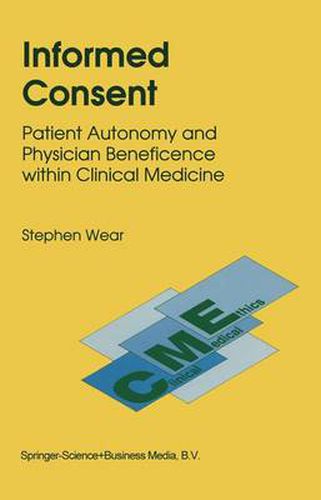Readings Newsletter
Become a Readings Member to make your shopping experience even easier.
Sign in or sign up for free!
You’re not far away from qualifying for FREE standard shipping within Australia
You’ve qualified for FREE standard shipping within Australia
The cart is loading…






This title is printed to order. This book may have been self-published. If so, we cannot guarantee the quality of the content. In the main most books will have gone through the editing process however some may not. We therefore suggest that you be aware of this before ordering this book. If in doubt check either the author or publisher’s details as we are unable to accept any returns unless they are faulty. Please contact us if you have any questions.
Substantial efforts have been made to reform the physician-patient relationship, particularly towards replacing the silent world of doctor and patient with informed patient participation in medical decision-making. This new ethos of patient autonomy has especially insisted on the routine provision of informed consent for all medical interventions. Strongly supported by most bioethicists and the law, as well as more popular writings, it seems clear that informed consent has, at best, been received in a lukewarm fashion by most clinicians, many simply rejecting what they commonly refer to as the myth of informed consent . The purpose of this text is to defuse this seemingly intractable controversy by offering an effective operational model of informed consent. This goal is pursued first by reviewing and evaluating, in detail, the agendas, arguments and supporting materials of its proponents and detractors. A comprehensive review of empirical studies of informed consent is provided, as well as detailed reflection on the common clinician experience with attempts at informed consent and the exercise of autonomy by patients. Ultimately, informed consent is recast as a management tool for pursuing clinically and ethically important values. The model incorporates a flexible, anticipatory approach that recognizes that no static, generic ritual can legitimately pursue the quite variable values that may be at stake with different patients in different situations. Finally, efficiency of provision is addressed by not pursuing the unattainable and ancillary. Throughout, the traditional principle of beneficence is appealed to towards articulating an operational model of informed consent as an intervention that is likely to change outcomes at the bedside for the better.
$9.00 standard shipping within Australia
FREE standard shipping within Australia for orders over $100.00
Express & International shipping calculated at checkout
This title is printed to order. This book may have been self-published. If so, we cannot guarantee the quality of the content. In the main most books will have gone through the editing process however some may not. We therefore suggest that you be aware of this before ordering this book. If in doubt check either the author or publisher’s details as we are unable to accept any returns unless they are faulty. Please contact us if you have any questions.
Substantial efforts have been made to reform the physician-patient relationship, particularly towards replacing the silent world of doctor and patient with informed patient participation in medical decision-making. This new ethos of patient autonomy has especially insisted on the routine provision of informed consent for all medical interventions. Strongly supported by most bioethicists and the law, as well as more popular writings, it seems clear that informed consent has, at best, been received in a lukewarm fashion by most clinicians, many simply rejecting what they commonly refer to as the myth of informed consent . The purpose of this text is to defuse this seemingly intractable controversy by offering an effective operational model of informed consent. This goal is pursued first by reviewing and evaluating, in detail, the agendas, arguments and supporting materials of its proponents and detractors. A comprehensive review of empirical studies of informed consent is provided, as well as detailed reflection on the common clinician experience with attempts at informed consent and the exercise of autonomy by patients. Ultimately, informed consent is recast as a management tool for pursuing clinically and ethically important values. The model incorporates a flexible, anticipatory approach that recognizes that no static, generic ritual can legitimately pursue the quite variable values that may be at stake with different patients in different situations. Finally, efficiency of provision is addressed by not pursuing the unattainable and ancillary. Throughout, the traditional principle of beneficence is appealed to towards articulating an operational model of informed consent as an intervention that is likely to change outcomes at the bedside for the better.